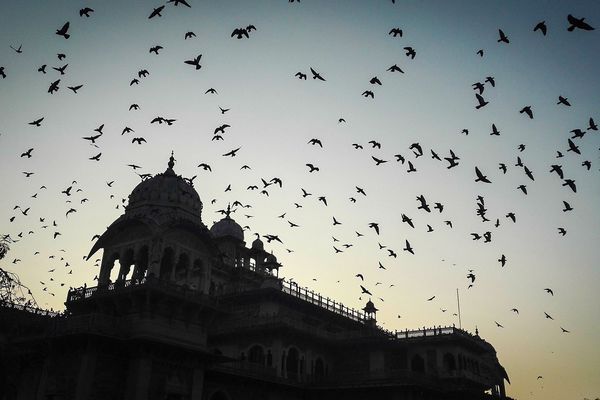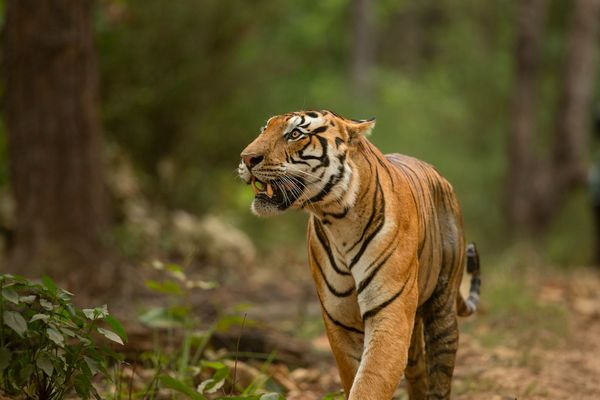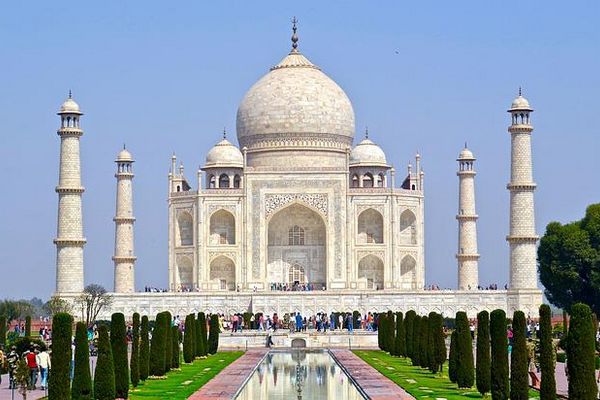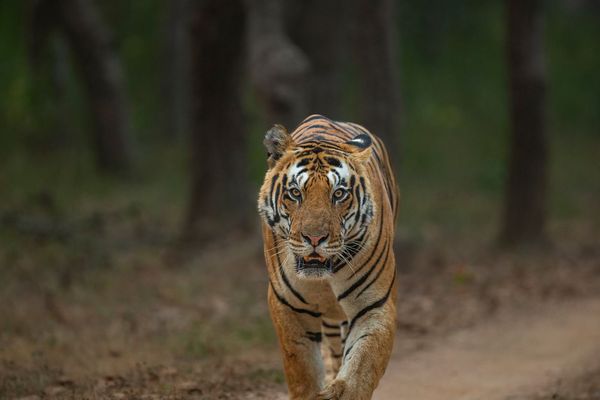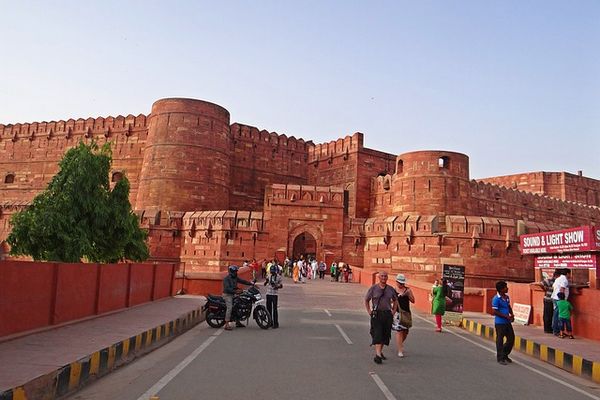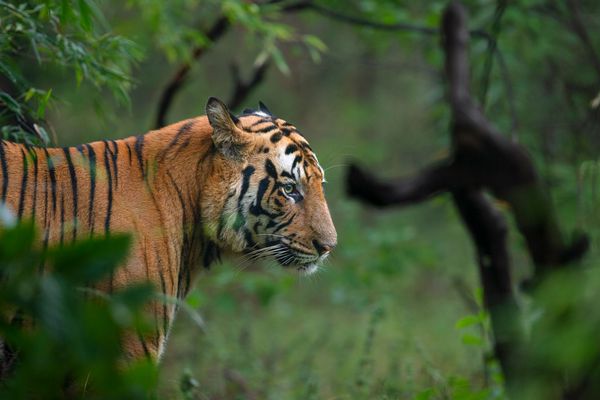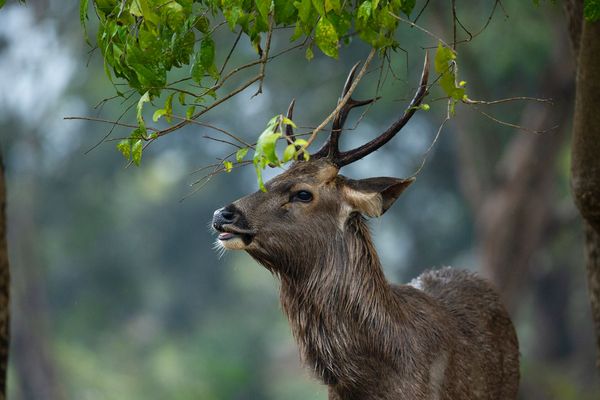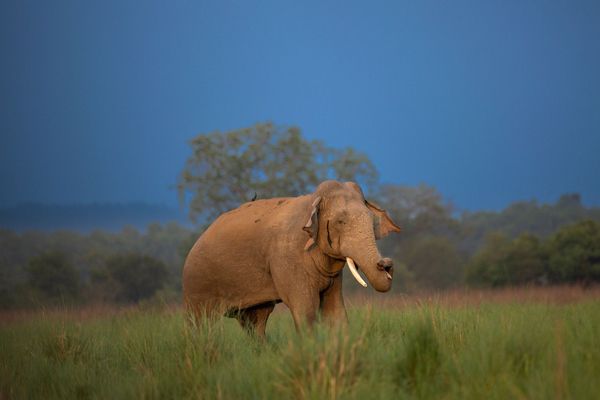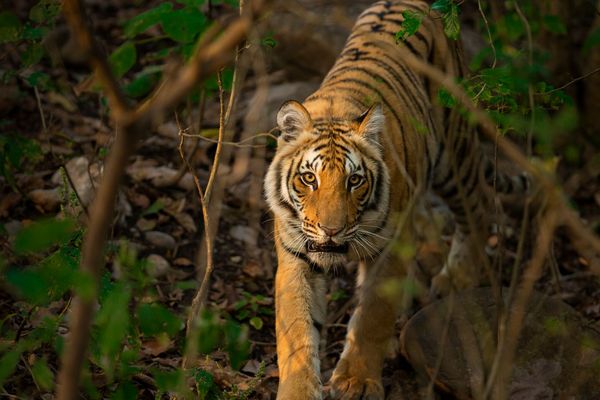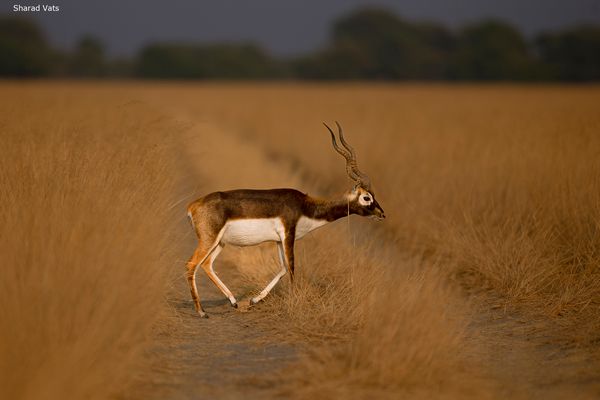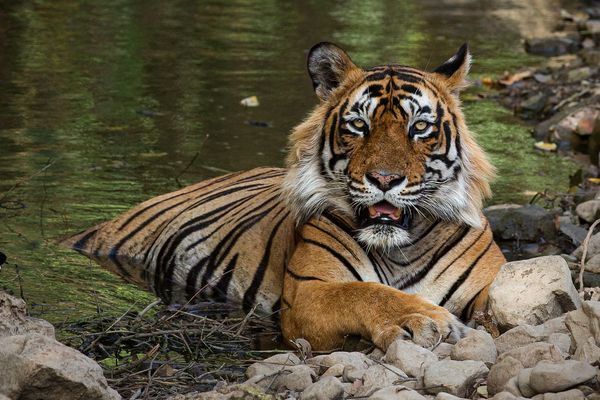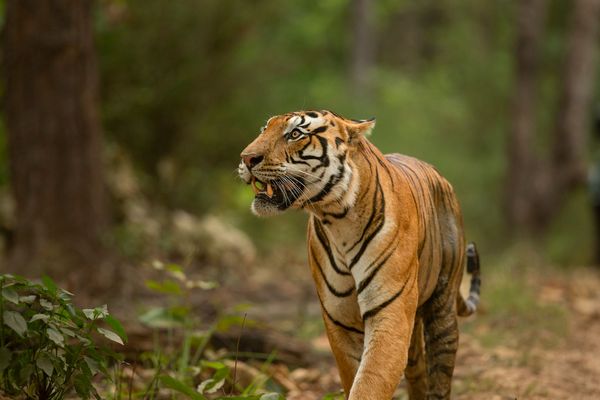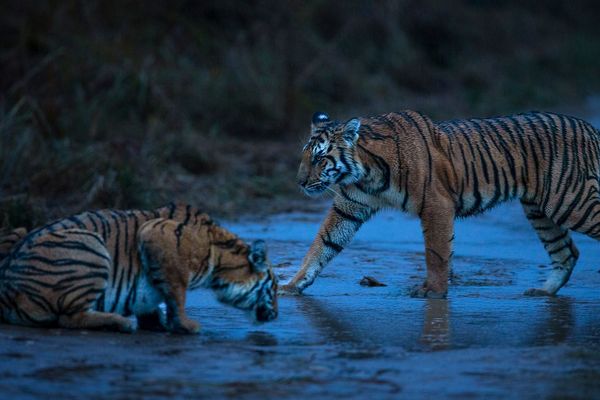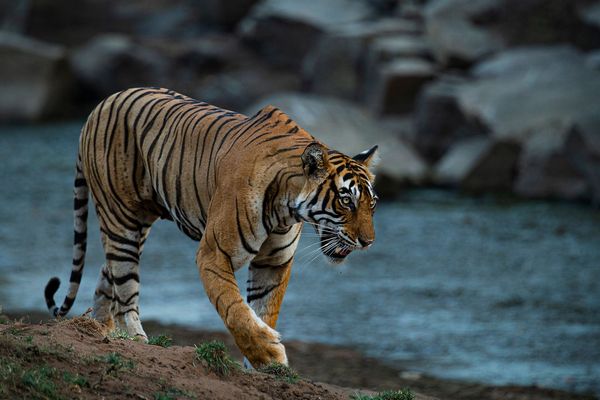Outline Tour Itinerary
- Day 01 : Arrival in New Delhi
- Day 02 : New Delhi – Corbett (275 kms/5 hrs drive)
- Day 03 : In Corbett National Park
- Day 04 : In Corbett National Park
- Day 04 : In Corbett National Park
- Day 05 : Corbett National Park – Agra (192 miles/6 hour drive)
- Day 06 : Agra – Ranthambore (275 kms/6 hrs drive)
- Day 07 : Ranthambore National Park
- Day 08 : Ranthambore National Park
- Day 09 : Ranthambore National Park – Jaipur (111 miles/3 hour drive)
- Day 10 : Jaipur – New Delhi (170 miles/6 hour drive)
- Day 11 : New Delhi – Raipur – Kanha (Flight + 210 kms/4 hrs drive from the airport)
- Day 12 : In Kanha National Park
- Day 13 : In Kanha National Park
- Day 14 : Kanha – Bandhavgarh (280 kms/6 hrs drive)
- Day 15 : In Bandhavgarh National Park
- Day 16 : In Bandhavgarh National Park
- Day 17 : Bandhavgarh – Khajuraho (280 kms/6 hrs drive)
- Day 18 : Khajuraho – Varanasi (Flight)
- Day 19 : In Varanasi
- Day 20 : Varanasi – New Delhi (Flight)
Guest Testimonials
Tiger Safari Tour in TIGER SAFARI AND TAJ MAHAL TOUR OF INDIA Overview
Tigers, the Taj Mahal, and temples are at the top of the list when it comes to the things that are crucial to India.
This trip to India, which includes a safari in search of tigers and a tour of the Taj Mahal, together with the mystique of Indian heritage and Indian culture, comprises the ideal combination of wild animals, intense spirituality, and religious observance. Whether it’s the religious festivities at Varanasi, the awe-inspiring Taj, or the elaborately carved temples of Khajuraho, you’re in for a tiger trip of a lifetime. This vacation combines famous tiger safaris in Ranthambore National Park, Bandhavgarh National Park, and Kanha National Park. As you traverse a voyage of cultural and natural discovery, an excursion through these formidable locations is certain to reinvigorate the body, spirit, and mind.
The tiger safari and Taj Mahal tour in India includes tiger safaris in India within four of the country’s most prominent national parks. These parks are Bandhavgarh National Park and Kanha National Park in central India, Corbett National Park in the terai belt, and Ranthambore National Park in western India.
The cultural component of the trip to India that includes a safari in search of tigers and a visit to the Taj Mahal will have you gawking in awe at the incredible piece of white marble that was constructed over three centuries ago. The tale of how this stunning structure came to be will move your heart in the same way that its outward aspect will do so; it is rightfully considered one of the seven wonders of the world. It is incomparable in terms of its splendour.
You will feel as though you have entered the lap of God when you visit Varanasi, the spiritual centre of India. It is a common belief that purging one’s body, mind, and soul of the sins accumulated over a lifetime can be accomplished by bathing in the Holy Ganges. If the river is responsible for the faith of 1.3 billion people, then it must have some significance. Varanasi is not the final stop on the spiritual journey. We also take you to Khajurao. In the heart of central India sits the city of Khajuraho, which is home to temples that date back a thousand years and have sexual carvings of Lord Shiva and Goddess Shakti.
On this incredible trip to India that includes a visit to the Taj Mahal and a tiger safari, we also take you to Khajurao. In the heart of central India sits the city of Khajuraho, which is home to temples that date back a thousand years and have sexual carvings of Lord Shiva and Goddess Shakti.
Get a Quote
Let’s plan a perfect tiger safari tour for you. Please fill in the details and our representative will get in touch with you within 12 hours with a custom-made tiger safari tour package. You can also reach us directly on +91-9811200094 or email us at [email protected].
TIGER SAFARI AND TAJ MAHAL TOUR OF INDIA Detailed Itinerary
- Day 1: Arrival in New Delhi
You will be greeted by a representative of our company when you arrive at the New Delhi Airport. This person will make sure that your transfer to the hotel goes without a hitch and will also assist you in checking in at the hotel. You will be provided with all of the travel paperwork and given an explanation of their purpose. Staying the night at the Hotel is included.
- Day 02 : New Delhi – Corbett (275 kms/5 hrs drive)
After a fulfilling breakfast, it is time to check out. Take the car and head to Corbett National Park. Traveling this distance by car will take you anywhere between 05 and 06 hours. The distance is 275 kilometres. When you arrive in Corbett, our officials as well as the guide and the driver will be there to greet you. They will assist you in moving your belongings into the safari jeep that you have reserved. You will be transported to the Dhikala Forest Lodge in this jeep (approximately 32 km from the gate). After completing the check-in process and lunch, you will then head out on a safari in the Dhikala Zone.
Return at sunset. The Forest Rest House was our destination for both supper and the night’s lodging.
- Day 03: In Corbett National Park
Visit Corbett National Park and go on safari both in the morning and in the evening. The Forest Rest House is where you should consume your meals and spend the night.
It is said that the land of the roar, trumpet, and singing can be found within the boundaries of the Corbett National Park. It presents a picture that is really breathtaking in its beauty. In India, the beginning of “Project Tiger” was marked with the opening of this park. The presence of a wide array of habitats inside this reserve is one factor that contributes to the high biodiversity found there. Because of its location in the foothills of the central Himalayas, the reserve is home to flora and animals native to both the Himalayas and the peninsula.
- Day 04 : In Corbett National Park
Included in this package are dinners, morning and afternoon jeep safaris, and a night’s stay at the Forest Rest House located within the National Park. The first and the best park in India, stretched over across 520 square kilometres. On August 8, 1936, the area that is now known as Ramganga National Park was first designated as Hailey National Park in honour of Sir Malcolm Hailey, who served as governor of the United Provinces at the time. The name of the park was changed to Ramganga National Park in 1952. It wasn’t until 1957 that it was officially designated as Jim Corbett National Park. Jim Corbett was a legendary hunter, naturalist-turned-author, and photographer who had assisted in the establishment of the park and the demarcation of its boundaries. In honour and memory of Jim Corbett, the park was named after him.
- Day 05 : Corbett – Agra (310 kms/6 hrs drive)
After breakfast in the early morning, you will need to check out. Drive to Agra, which is a distance of 310 kilometres. This should take you approximately six hours to complete. Get to Agra by the late afternoon at the latest. Enjoy the day at your own leisure. A hotel in Agra for dinner and the night’s accommodations.
- Day 06 : Agra – Ranthambore (275 kms/6 hrs drive)
Visit the Taj Mahal, one of the seven wonders of the world, in the morning. This incredible structure is often regarded as one of the greatest buildings ever constructed. It was designed by the Mughal emperor Shah Jehan to be a monument of love for his wife Mumtaz, and it was constructed in the middle of the 1700s. Over 20,000 people from different parts of the world contributed their time and effort to the construction of this magnificent mausoleum. It was immortalised in white Makrana marble and embellished with onyx, amethyst, lapis lazuli, turquoise, jade, crystal, and several other semi-precious stones that were brought from as far away as Tibet, China, and the Indian Ocean.
Following lunch, make your way to Ranthambhore. Arrive at your safari lodge and check in. After lunch, you should get ready for the afternoon safari.
(It is important to note that visitors will not be able to access the Taj Mahal on Fridays.)
- Day 07 & 08 : Ranthambore National Park
On both days, you should go on the park’s safaris in the morning and the evening.
The entirety of the park is separated into ten distinct zones, and the majority of these zones support healthy populations of tigers and other animals. Project Tiger was initiated in Ranthambore National Park, which was one of the very first national parks to host the programme. It has had a fluctuating Tiger population over the course of the past century, but Ranthambore has been on a rather even keel over the course of the past decade. To such an extent that it was able to donate a few tigers to Sariska National Park, which was devoid of tigers as a result of activities known as poaching.
Both the hardworking Forest Department and the tourism industry deserve all of the credit for Ranthambore’s success, which includes a robust tiger population. The Ranthambore Tiger Reserve is located in the state of Rajasthan in India. It is made up of several distinct areas, each of which has its own unique conservation history. These areas are also geographically distinct from one another, with only a few narrow corridors connecting them to Ranthambore National Park, the reserve’s central location. The majority of these are located in Ranthambore National Park, Sawai Mansingh Sanctuary, and Keladevi Sanctuary.
The Indian golden triangle trip and tiger safari both include a stop to the spectacular Ranthambore National Park, which is a photographer’s dream location. Ranthambore is attractive in its own unique manner since there are so many different types of lighting, perspectives, and backdrops, and you can take pictures there using any frame you like. In addition, there are over 300 different species of birds that may be found inside the park’s boundaries. Ranthambore National Park and the areas surrounding it are, in point of fact, a bird watcher’s dream come true.
The large cormorant, the painted spurfowl, the sarus crane, the bronzed winged jacana, the sandpiper, the kingfisher, the nightjar, the painted sandgrouse, and the great horned owl are just some of the key species that make their annual migration from their breeding grounds to the north of the Himalayas to Ranthambore and the areas surrounding it for the winter.
The name of this park, which spans an area of 400 square kilometres and is home to rocky hill crests that descend to open valleys between the Aravali and Vindhya ranges, is derived from the thousand-year-old fortress that looms above the forest. Ranthambore is home to a wide variety of flora and fauna, including tigers, leopards, and sloth bears. Ranthambore is a very rare and unusual region where a natural present meets a historical past. It is most well-known for the diurnal activity of tigers, which may be seen there. Sambar, Cheetal, Chinkara, Nilgai and Languor. This reserve is home to the elusive leopard as well as tigers, and visitors who go on safari have a very strong chance of spotting tigers during their excursions. The crumbling remnants of its former greatness may be found strewn across the terrain. These ruins can take the form of chatris or cupolas, and they resemble palaces or old guard stations. These ruins all contribute to the mystical and ethereal atmosphere of this vast wilderness. Overnight stay at the Resort, together with all meals.
- Day 09 : Ranthambore National Park – Jaipur (111 miles/3 hour drive)
You will have breakfast first thing in the morning, then check out and drive to Jaipur. It will take around three hours to reach a distance of 180 kilometres. Check into your hotel as soon as you get there. After a filling lunch, you will next go sightseeing in Jaipur’s most famous attractions (Jantar Mantar, Hawa Mahal, City Palace and the Museum). Another thing that makes this city famous is its shopping. When you visit the ‘Jaipuri Bazaar,’ you will notice that the culture is much more vibrant than usual due to the abundance of rare stones and handicrafts.
Come back to the hotel, where you can relax for the rest of the evening.
- Day 10 : Jaipur – New Delhi (170 miles/6 hour drive)
It is time to check out of the hotel after breakfast. Pay a visit to the Amer Fort, which served as the home of the Rajput Maharajas and their families in the past. It is a luxurious palace that has been built on a total of four storeys. In addition to being a hill fort, this location is also a World Heritage site. After that, continue driving for around five to six hours over 275 kilometres to reach New Delhi, which is the capital of India.
- Day 12 - 13 : In Kanha National Park
You need to be awake and ready to go on your first early morning safari at Kanha National Park by 05:00 hours. The Sal and Bamboo woods, rolling meadows, and meandering streams that make up the majority of the Kanha Tiger Reserve were established in 1974 as part of Project Tiger. This reserve encompasses a total area of 940 square kilometres and is known for its spectacular natural grandeur. The park is the only place in the world where the endangered Hard Ground Barasingha may be found (Cervus Duvaceli Branderi).
This is the country that Kipling first explored and wrote about in such vivid detail in his book “The Jungle Book.” The breakfast that was packed for you at the lodge is served at the predetermined location and is put out on the hood of the safari vehicle. Have a wonderful time eating your breakfast at the Kanha National Park. You should keep looking for the elusive tiger if you haven’t already spotted one, and in the meantime, you should take in the beautiful and revitalising scenery around you. The time to return from the safari is approximately 11:30. Refresh yourself and have some lunch.
The afternoon will be spent on a jeep safari around Kanha National Park, and the trip will end at 1800 hours. Unwind, enjoy some food and drink, and spend the night at the lodge.
- Day 14 : Kanha – Bandhavgarh (280 kms/6 hrs drive)
The Bandhavgarh National Park is accessible to tourists after they have consumed a little breakfast there. Traveling this distance by car will take you around six hours due to the 280 kilometres involved. The visitor will be able to check in at the lodge once they have arrived. After having lunch, you will go on an afternoon safari through the park, and then you will spend the night at the lodge.
After the morning’s safari, come back to the lodge and refresh yourself. After a laid-back lunch, it’s time to start your afternoon safari in the unspoiled nature of Kanha National Park.
- Day 15 - 16 : In Bandhavgarh National Park
Participate in the safaris both in the morning and in the evening. Savor each of your meals, and plan to spend the night at the lodge.
The high number of tigers that can be found in Bandhavgarh is the primary reason for the park’s fame. Other wild animals that can be seen in the park include leopards, blue bulls, indian gaurs (bison), chausingha (four-horned antelopes), spotted deers, sambar deer, wild boar, sloth bears, foxes, jackals, wild dogs, and more. The park is home to over 250 different bird species and at least 22 different types of mammals. The Lesser Bandicoot Rat, the Palm Squirrel, the Ratel, the Porcupine, the Small Indian Civet, the Jungle Cat, and the secretive Hyenas are some of the other animals that can be found in Bandhavgarh. In addition to turtles and monitor lizards, the park is home to a variety of reptiles such as cobras, kraits, vipers, ratsnakes, pythons, and rat snakes. Bandhavgarh is home to two different types of primates, specifically the Rhesus Macaque and the Hanuman Langur.
After the morning and evening safaris at the park, appreciate the flavour of each meal and spend the night at the park so you may continue your experience the next day.
- Day 17 : Bandhavgarh – Khajuraho (280 kms/6 hrs drive)
After breakfast, continue on to Khajuraho after going on a wildlife drive in the national park in the morning. The entire tour covers approximately 280 kilometres, and it will take you approximately six hours to drive it. When you get there, check into the hotel. Khajuraho city tour in the afternoon.
It was pure luck that led to the discovery of Khajuraho, which is now India’s second-biggest single tourist destination. To celebrate the stylized and polished courtly triumphs of beauty, love, and creative arts, Khajuraho is home to the biggest set of temples that date back to the mediaeval period. These temples are ornamented with countless sculptures that exhibit amazing elegance and delicacy. Temples in the city date back to between the years 950 and 1050 AD, when it served as the religious capital of the Chandela Rajputs. The entire area is enclosed by a wall that has eight gates, and there are two golden palm palms on either side of each gate. Originally, there were more than 80 temples, but only 22 of them are still exceptionally well kept now.
The group of temples at Khajuraho that celebrate Hindu religious philosophy in its baffling range of scope and inclusion stands apart from the rest of the Hindu temples because of the breadth and depth of its scope. The temples bring attention to the existential philosophy of religion, which reveres the concepts of “Yoga” and “Bhoga.” “Bhoga” refers to the route that leads to God through sensual pleasure, whereas “Yoga” refers to the union of the self with the Almighty. The temples of Khajuraho, which are devoted to sexuality and sensual pleasure, are a living testament to this philosophical perspective. Khajuraho is a remarkable, must-see location that was inscribed on the UNESCO World Heritage List in 1986. Its temples are India’s one-of-a-kind gift to the rest of the world because they depict life in all of its forms and moods in stone. Sound and light performance performed in the evening at Khajuraho. Spend the night in the hotel that is located in Khajuraho.
- Day 18 : Khajuraho – Varanasi (Flight)
After breakfast in the morning, you should travel to the Eastern and Southern group of temples. The largest Jain temple in the Eastern group is the Parasvanath temple, which can be found in the Eastern group. The themes show activities that people do on a daily basis in endearingly specific detail. You should also go to the temple of Kandariya Mahadev, which is dedicated to Shiva, as well as the temple of Chaturbhuj, which belongs to the Southern group.
Transfer in the afternoon to get you to the airport in time for your trip to Varanasi. Leave Khajuraho for Varanasi. When you arrive at the Varanasi airport, you will be greeted and assisted, and then transferred to the hotel.
One of the most significant pilgrimage locations in all of India, Varanasi is considered by Hindus to be the holiest of sacred towns. Varanasi, sometimes referred to as Kashi and Benaras, is widely regarded as one of the world’s oldest continuously inhabited cities. For well over two thousand years, it has served as a pivotal location for intellectual and cultural exchange.
Evening: Walk along the Ganga River and see one of its “Ghats,” or banks. The cultural ethos that directs the life of the devout may be experienced by those who go on this walk, which is why it is so interesting. Observe the ceremonies that are performed in response to the sun going down as well as the ablution rites that are carried out in the river. You will witness boats floating down the river, some bringing items such as fruits and vegetables, and others transporting people who are participating in religious activities along the riverbank.
You can observe some people engaged in prayer and the chanting of hymns on the banks, while others are engaged in trade, and yet others are performing duties such as hair cutting, massaging, and even cleaning ears! Walk across to the Manikarnika Ghat, where you will be able to observe cremation being carried out with a great deal of ritual. This is the technique that is used to convey the departed soul to the sky. When one’s life comes to an end, Hindus believe that it is possible for their souls to be reincarnated “in a higher state” and that the gateway to the heavens can be found in the city of Varanasi. Overnight in Varanasi.
- Day 19 : In Varanasi
Take a boat trip at dawn down India’s holiest river, the Ganges. This is a great way to start the day. Pilgrims kneeling in water up to their waists and praying before the dawning of a new day is a magnificent and incredibly peaceful scene to witness at the sacred river. Visit the well-known Vishwanath temple, which is devoted to Shiva, the reigning god of the city. The spires of the temple are plated with gold. Come back to the hotel in time for breakfast.
Visit also the city of Sarnath, which is situated 13 kilometres to the north-east of Varanasi, close to the point where the Ganges and Gomati rivers converge in Uttar Pradesh, India. It was at the deer park of Sarnath that Gautama Buddha gave his first sermon on the Dharma. It was also in this location that Kondanna attained enlightenment, which led to the establishment of the Buddhist Sangha. Shreyansanath, the eleventh Tirthankara of Jainism, was born in Singhpur, a village that is approximately one kilometre distant from the spot. There is also a temple in Singhpur that is dedicated to him. Overnight in Varanasi.
- Day 20 : Varanasi – New Delhi (Flight)
You have the morning free to relax and pack at your own pace. After that, make your way to the airport to check in for your 10:15 p.m. flight to New Delhi. 11:50 is the time of arrival in New Delhi. After being picked up at the airport, you will be taken to a hotel that is conveniently located near the airport so that you may freshen up and change before continuing on to the international airport to board your flight either back home or to your next destination.
Enquire This Tour
Let’s plan your tiger safari tour. Please fill in the requirements below and our representative will get back to you with a custom safari package.
Guest Testimonials
What our guests are saying about us?

My husband and I did a 10 day "Just Tigers" safari. We visited Pench, Kanha and Bandhavgarh reserves. It was not high season but yes we had wonderful tiger sightings. The level of profession of these lovely people was so refreshing. For this type of trip you do want people who know what they are doing and a comfortable place to return to after long safari drives.

India. A country that has fascinated me for years. I finally decided it was time to visit and see it for myself. My husband and I both love nature, wildlife and birds so when I came across Nature Safari India I decided to make enquires.
We wanted to do the golden triangle tour as well as visiting national parks and seeing some of the ‘real’ India.

This is the 2nd time we have travelled with Nature Safari India. We had a 17 night holiday, visiting the nature of Sasan Gir National Park, Little Rann of Kutch, Velavadar Black Buck National Park and Leopard Hills at Bera. The nature was interspersed with various amounts of culture along the way. We had another amazing tour, with some stunning accommodation selected by the company

This was our second tiger safari at Corbett with Nature Safari and turned out to be worth every penny. We saw 7 tigers in 3 days and from quite close distance too. The best part was seeing a tigress wit her 2 grown cubs who crossed our path and walked in front of us for several minutes before crossing over and heading to a water hole where we saw them for hours drinking


